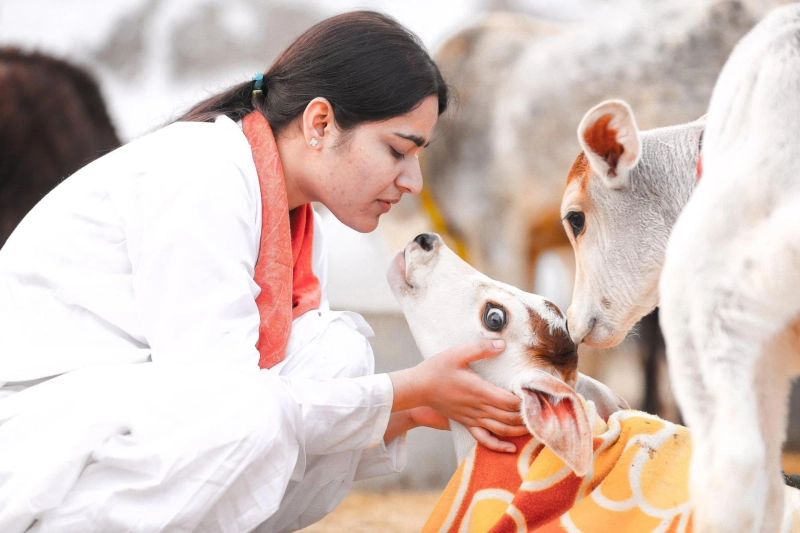Cow protection, or Gau Raksha, has been an integral part of India’s cultural, spiritual, and rural life for centuries. Revered as a symbol of motherhood, nourishment, and divinity, the cow occupies a central place in Indian traditions. In Uttar Pradesh, this reverence has translated into numerous initiatives aimed at cow welfare. Among the voices leading with devotion and action is Krishnapriya Ji Maharaj, a young Spiritual Orator and Spiritual Speaker, who not only preaches compassion but also actively manages a Gaushala (cow shelter) dedicated to Gau Seva.
The Significance of Gau Raksha in Indian Society
Cow protection has historically been seen as a sacred duty. Beyond its spiritual symbolism, the cow continues to play an economic and ecological role—supporting agriculture, providing dairy, and even contributing to organic farming practices. In states like Uttar Pradesh, where large rural populations still depend on cattle, Gau Raksha is not merely ritualistic but also socio-economic in nature.
Uttar Pradesh: A Center of Cow Protection Initiatives
Uttar Pradesh has seen a rise in organized efforts to create shelters and protect stray, abandoned, or injured cows. The state government has launched several programs for Gaushalas, alongside community-driven initiatives supported by saints, devotees, and NGOs. Yet, challenges such as overcrowding, limited resources, and lack of medical infrastructure highlight the importance of spiritual leaders who combine faith with social reform.
Krishnapriya Ji’s Role in Gau Seva
Known as Devi Krishnapriya, she has become a beacon of compassion not only through her kathas but also through her social service. Her Gaushala in Uttar Pradesh stands as a living example of her philosophy—that divinity is experienced not just in temples but in serving living beings.
Her cow shelter provides:
- Food and care for abandoned and stray cows.
- Medical aid for injured and sick animals.
- A safe environment for cows rescued from neglect or cruel conditions.
Through her 360 Kathas initiative, funds and awareness are directed toward sustaining cow welfare, ensuring that Gau Raksha remains active service and not symbolic rhetoric.
Blending Tradition with Modern Welfare
While Gau Raksha often invokes tradition, Krishnapriya Ji’s work shows that it can be deeply practical and future-driven. From promoting organic farming practices tied to cow-based products to community participation in feeding drives, her initiatives reflect how spirituality can evolve into sustainable welfare.
Beyond Gau Raksha: A Holistic Vision
For Krishnapriya Ji Maharaj, cow protection is part of a broader vision of compassion. Her efforts include child welfare, women empowerment, and animal rights, showcasing her belief that devotion should manifest in service to all beings. Gau Seva, therefore, is not just about protecting cows—it is about cultivating a culture of respect, gratitude, and harmony with nature.
Devi Krishnapriya ji Official Website:- https://devikrishnapriya.com/
Also read us:- https://www.aajtak.in/india/uttar-pradesh/story/sadhvi-krishnapriya-story-vrindavan-mathura-gaushala-lclv-1469271-2022-05-28
FAQs
What is the significance of Gau Raksha in Indian culture?
Gau Raksha, or cow protection, has been part of India’s spiritual and cultural tradition for centuries. The cow is considered sacred, symbolizing motherhood, nourishment, and ecological balance.
2. How is Krishnapriya Ji involved in cow protection?
Krishnapriya Ji Maharaj runs a Gaushala (cow shelter) in Uttar Pradesh where stray, abandoned, and injured cows are given food, medical treatment, and a safe environment.
3. Why are Gaushalas important in today’s society?
Gaushalas provide shelter and care for cows that might otherwise suffer from neglect. They support animal welfare, promote organic practices, and maintain the cultural tradition of compassion.
4. How is Krishnapriya Ji’s Gaushala funded?
The Gaushala is supported through community participation and donations raised from her 360 Kathas and spiritual discourses, which combine devotion with social service.
5. What makes Krishnapriya Ji’s approach unique?
Her approach blends spirituality with practical welfare. She emphasizes that true devotion is expressed not only in prayer but in active service to animals and society.


